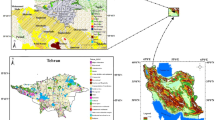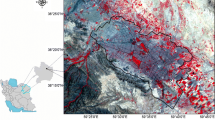Abstract
The urbanization process causes the urban heat island effect and affects the urban climate change. The urban heat island intensity is often used to describe the urban thermal environment, but how to objectively and scientifically obtain the urban heat island intensity is a research difficulty. This paper uses remote sensing data, OpenStreetMap data, climate data and other data, based on the local climate zones framework, combined with surface temperature retrieval, GIS spatial analysis and other methods, to study the urban thermal environment differences in Wuhan. The research shows that the rapid acquisition method of the area of interest based on OpenStreetMap data can better realize the local climate classification. The overall accuracy is 77.1% and Kappa coefficient is 0.75, which meets the accuracy requirements. On this basis, by superimposing the results of surface temperature retrieval from remote sensing images, the thermal characteristics of ground objects of different local climate types in the city can be obtained, thereby comprehensively reflecting the differences in the thermal environment in the city.
Access this chapter
Tax calculation will be finalised at checkout
Purchases are for personal use only
Similar content being viewed by others
References
World Urbanization Prospects: The 2018 Revision (2018)
Manley, G.: On the frequency of snowfall in metropolitan England. Q. J. Roy. Meteorol. Soc. 84, 70–72 (1958)
X, A., J, T., X, Z.: The synergistic effect of urban heat and heatwave in Shanghai and its influencing island factor. J. Geogr. Sci. 14 (2019)
Ward, K., Lauf, S., Kleinschmit, B., Endlicher, W.: Heat waves and urban heat islands in Europe: a review of relevant drivers. Sci. Total Environ. 569–570, 527–539 (2016)
Yang, X., et al.: Contribution of urbanization to the increase of extreme heat events in an urban agglomeration in east China. Geophys. Res. Lett. 44, 6940–6950 (2017)
Georgescu, M., Moustaoui, M., Mahalov, A., Dudhia, J.: Summer-time climate impacts of projected megapolitan expansion in Arizona. Nat. Clim. Change 3, 37–41 (2012)
Zhou, D.C., Zhao, S.Q., Liu, S.G., Zhang, L.X.: Zhu: Surface urban heat island in China’s 32 major cities: spatial patterns and drivers. Remote Sens. Environ. 2014(152), 51–61 (2014)
Zhao, L., Smith, R.B., Oleson, K.: Strong contributions of local background climate to urban heat islands. Nature 511, 216–219 (2014)
Kolokotroni, M., Ren, X., Davies, M., Mavrogianni, A.: London’s urban heat island: Impact on current and future energy consumption in office buildings. Energy Build. 47, 302–311 (2012)
Tomlinson, C.J., Chapman, L., Thornes, J.E., Ba Ker, C.J.: Including the urban heat island in spatial heat health risk assessment strategies: a case study for Birmingham, UK. Int. J. Health Geogr. 10, 1–14 (2011)
Yan, Z., Shepherd, J.M.: Atlanta’s urban heat island under extreme heat conditions and potential mitigation strategies. Nat. Hazards 52, 639–668 (2010)
Stewart, I.D., Oke, T.R.: Local climate for urban temperature studies. Bull. Am. Meteorol. Soc. 93, 1879–1900 (2012)
Chung, S.C., Chao, R.: Outdoor thermal comfort in different urban settings of sub-tropical high-density cities: an approach of adopting local climate zone (LCZ) classification. Build. Environ. 154, 227–238 (2019)
Kotharkar, R., Bagade, A., Ramesh, A.: Assessing urban drivers of canopy layer urban heat island: a numerical modeling approach. Landsc. Urban Plann. 190, 103586 (2019)
Ran, W.A., Meng, C.A., Chao, R., Bb, D., Yong, X.E., Ena, B.: Detecting multi-temporal land cover change and land surface temperature in Pearl River Delta by adopting local climate zone. Urban Clim. 28, 100455 (2019)
Wang, C., Middel, A., Myint, S.W., Kaplan, S., Brazel, A.J., Lukasczyk, J.: Assessing local climate in arid cities: the case of Phoenix, Arizona and Las Vegas, Nevada. ISPRS J. Photogram. Remote Sens. 141, 59–71 (2018)
Mushore, T.D., et al.: Remotely sensed retrieval of local climate and their linkages to land surface temperature in Harare metropolitan city, Zimbabwe. Urban Clim. 27, 259–271 (2018)
Geleti, J., Lehnert, M., Dobrovoln, P.: Land Surface temperature differences within local climate, based on two central European cities. Remote Sens. 8, 788 (2016)
Yuan, S., Ka-Lun, L.K., Chao, R., Edward, N.: Evaluating the local climate zone classification in high-density heterogeneous urban environment using mobile measurement. Urban Clim. 25, 167–186 (2018)
Benjamin, B., et al.: Mapping local climate for a worldwide database of the form and function of cities. Int. J. Geo-Inf. 4, 199–219 (2015)
Wuhan Municipal Bureau of Statistics: Wuhan Statistical Yearbook 2021. China Statistics Press, Beijing (2021)
Demuzere, M., Kittner, J., Bechtel, B.: LCZ generator: a web application to create local climate zone maps. Front. Environ. Sci. 9, 637455 (2021)
Danylo, O., See, L., Bechtel, B., Schepaschenko, D., Fritz, S.: Contributing to WUDAPT: a local climate zone classification of two cities in Ukraine. IEEE J. Sel. Top. Appl. Earth Observ. Remote Sens. 9, 1841–1853 (2017)
Hidalgo, J., Schoetter, R., Petit, G., Bocher, E., Dumas, G.: Comparing WUDAPT level 0 cartography with a more detailed urban database. Some examples for French cities using the MAPUCE database (2017)
See, L., et al.: Generating WUDAPT’s specific scale-dependent urban modeling and activity parameters: collection of level 1 and level 2 data (2015)
Yong, X., Chao, R., Meng, C., Edward, N., Wu, T.: Classification of local climate using ASTER and landsat data for high-density cities. IEEE J. Sel. Top. Appl. Earth Observ. Remote Sens. 10, 1–9 (2017)
Rozenstein, O., Qin, Z., Derimian, Y., Karnieli, A.: Derivation of land surface temperature for landsat-8 TIRS using a split window algorithm. Sensors 14, 5768–5780 (2014)
Jimenez-Munoz, J.C., Sobrino, J.A., Skokovic, D., Mattar, C., Cristobal, J.: Land surface temperature retrieval methods from landsat-8 thermal infrared sensor data. IEEE Geosci. Remote Sens. Lett. 11, 1840–1843 (2014)
Wang, S., He, L., Hu, W.: A temperature and emissivity separation algorithm for landsat-8 thermal infrared sensor data. Remote Sens. 12, 9904–9927 (2015)
Chen, D., Ren, H., Qin, Q., Meng, J., Zhao, S.: A practical split-window algorithm for estimating land surface temperature from landsat 8 data. Remote Sens. 7, 647–665 (2015)
Author information
Authors and Affiliations
Corresponding author
Editor information
Editors and Affiliations
Rights and permissions
Copyright information
© 2022 The Author(s), under exclusive license to Springer Nature Switzerland AG
About this paper
Cite this paper
Wang, S., Fan, Z., Fan, W. (2022). Study on the Differences of Urban Thermal Environment Under the Framework of Local Climate Zones. In: Wu, H., et al. Spatial Data and Intelligence. SpatialDI 2022. Lecture Notes in Computer Science, vol 13614. Springer, Cham. https://doi.org/10.1007/978-3-031-24521-3_16
Download citation
DOI: https://doi.org/10.1007/978-3-031-24521-3_16
Published:
Publisher Name: Springer, Cham
Print ISBN: 978-3-031-24520-6
Online ISBN: 978-3-031-24521-3
eBook Packages: Computer ScienceComputer Science (R0)




